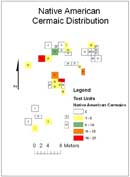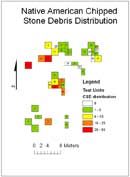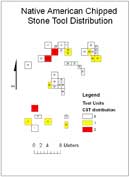Native American artifacts
Native American Ceramic Analysis
Introduction
The ceramic analysis for the Beaver Creek Trail Crossing Site was conducted on a very limited number of artifacts collected during the 2005 field season. The goal of the analysis was to determine what information could be gathered from the material.
Methods
All ceramic sherds were dry brushed to remove excess dirt as part of the Research Methods class taught by Dr. Demers in the fall of 2005. The ceramics were separated for future analysis as part of the class as well. The lithics were size-graded using circles with an expanding diameter gradient ranging from 1 cm to 8 cm. Each sherd was defined as a body, rim, neck, or base. Objects less than 1 cm and objects greater than 8 cm were classified as >1 cm and <8 cm, respectively. The sherds were grouped by provenience.
Analysis
The majority of the sherds fall between 1 and 2 cm in diameter 87 of 112 or 71 percent with the remainder being roughly split between less than 1 cm in diameter and between 2 and 3 cm. One fifth of the 122 sherds were found in test unit 18. This was the highest concentration of sherds. See Figure 13.1 for the distribution of the ceramics in each test unit. All but one of the sherds found were undecorated smooth body sherds. One rim sherd with a small finger impressed decoration was discovered. The sherds were extremely variable in thickness and no attempt was made to quantify this. The temper of the sherds was difficult to determine as many do not show any visible temper. However a few sherds contained grit temper.
Discussion and Conclusion
Little can be said for certain about the ceramics at 25SW49. The sherds most likely date from 1500–1750 C.E. The undecorated nature of the sherds may represent simple utilitarian vessels that were not worth embellishing, but even this is speculation due to the very small sample size. The presence of ceramics does suggest some kind of temporary camp or other short-term occupation. The lack of any post-holes, hearths or other evidence of more permanent settlement supports this hypothesis. All that is certain is that ceramics were broken and discarded or discarded and broken at the site.
Native American Lithic Analysis
Introduction
Lithic analysis for the Beaver Creek Trail Crossing Site was conducted on a sparse assemblage of lithic artifacts collected during the 2005 field season. The goal of the study was to determine how many and what type of tools are present at the site and what rock material the objects were made from. Also, inferences will be made as to the kind of occupation the lithics may represent and how the type and condition of the lithics speaks to this occupation.
Methods
The lithic materials were washed using water and brushes and left to dry in the historic archaeology lab the University of Nebraska–Lincoln. This was accomplished as part of the Research Methods class taught by Dr. Demers in the fall of 2005. The lithics were also identified and catalogued.
The lithics were size-graded using circles with an expanding diameter gradient ranging from 1 cm to 8 cm. Each object was assigned to a size class and then identified according to object type (tools, flakes, shatter, etc.). Objects less than 1 cm and objects greater than 8 cm were classified as <1 cm and >8 cm, respectively.
Flakes and tools were analyzed separately. Flakes were categorized according to completeness. First, flakes from each provenience were identified as either complete or incomplete. The incomplete flakes were further categorized as proximal, medial, distal, or unknown. Those objects identified as tools were described (i.e. as end-scrapers, bifaces, cores, etc.), and measurements of length, width, and thickness were obtained. Color was determined using a Munsell soil color chart.
Tools and Flakes
Stone tools are those artifacts that have been intentionally modified by use or show signs of unintentional wear (Andrefsky 1998:xxvii). The assemblage from 25SW49 contains 16 tools that include: a core, projectile points, scrapers, and unknown retouched tools. Three hundred forty four flakes were also collected. For a distribution of lithic materials see Figure 13.2 and Figure 13.3 for the distribution of chipped stone debris and chipped stone tools respectively. One projectile point was discovered on the west side of the creek, but was not included in the distribution because the distance of this test unit from the other was too great to facilitate mapping.
Cores
One core was identified in the assemblage. For this study, a core is defined as a nucleus of rock that shows signs of multiple pieces being detached, and that has not been used in another manner as a tool (Andrefsky 1998:xxvii). The core is from provenience 25SW49.0080; test unit 11, level 4. Also, this core was found in Feature 4, a concentration of mortar. The core is unrelated to this feature. The core measures 37.4 mm in length, 27.6 mm in width, and has a thickness of 20.6 mm, and has roughly 20 flake scars. The core is a strong brown 7.5YR 4/6 on the Munsell color chart with olive gray 5Y 4/2 coloration on one side. The core is made from Republican River Jasper from areas along the Kansas-Nebraska border, and as such would not have been locally available to the occupants of the site.
Projectile Points
Four projectile points were recovered during excavation. A projectile point is defined as a biface with a hafting area and a point that was used as a dart, spear, or arrow tip (Andrefsky 1998:xxvi). At Beaver Crossing the points found are relatively small and represent specialized arrow or spear points for taking small to medium size game.
The first point found was a triangular unnotched concave base point measuring 14.7 mm in length, 14.1 mm in width, measuring 14 mm from top to middle of base, and has a thickness of 2.2 mm. It was found in provenience 25SW49.0010; test unit 3, level 3. The point has cortex on one side. The point is brown to dark brown 10 YR 4/3.
The second was found in provenience 25SW49.0078; test unit 16, level 2. This point is side notched with a convex base measuring 12.8 mm in length, 11.0 mm in width, and has a thickness of 2.9 mm. The color is gray 10YR 5/1.
The third was found in provenience 25SW49.0127; test unit 20, level 3, feature 6. The point is an asymmetrical triangular fragment with the base and tip missing, measuring 15.0 mm in length, 13.2 in width, and has a thickness of 2.8 mm. The color is dark red 2.5YR 3/6.
The fourth was found in provenience in 25SW49.0104; test unit 20, level 4. The point is triangular with the tip and part of the base missing, measuring 17.3 mm in length, 15.4 mm in width, and has a thickness of 3.5 mm. The color is dark yellowish brown 10YR 4/6.
Scrapers
Four scrapers were excavated. A scraper is defined as a flake tool with a retouched edge of approximately 60 to 90 degrees (Andrefsky 1998:xxvi). All the scrapers found are end scrapers. On this type of scraper the distal portion of the tool was used to do the scraping. Scrapers would have been used for a variety of purposes. Hides had to have the fat and tissue scraped off them to allow the material to cure into leather. Wood or bone could have been worked in some manner.
The first scraper was found in provenience 25SW49.0002; test unit 2, level 1. The scraper is only the distal portion with the rest snapped off. It measures 9.2 mm in length, 16.3 mm in width, has a thickness of 7.7 mm, and is grayish brown 5/2 10 YR.
The second scraper was found in provenience 25SW49.0022; test unit 2, level 3. The end scraper is only the distal portion with the rest of the tool snapped off. It measures 14.1 mm in length, 20.8 mm in width, and has a thickness of 4.5 mm, and has three bands with colors reddish yellow 7.5YR 6/6, pale yellow 7.5YR 8/3, and olive 5Y 4/4.
The third scraper was found in provenience 25SW49.0064; test unit 15, level 2. The end scraper is only the distal portion with the rest of the tool snapped off. It measures 10.7 mm in length, 12.0 mm in width, has a thickness of 4.7 mm. Its color is reddish yellow 7.5YR 6/6.
The fourth scraper was found in provenience 25SW49.0103; test unit 19, level 5. The end scraper has the proximal portion broken off, but is otherwise complete. It measures 21.7 mm in length, 19.2 mm in width, has a thickness of 5.1 mm. Its color is strong brown 7.5YR 5/8. This scraper is an example of Hartville Chert found in east central Wyoming.
The fifth scraper was found in provenience 25SW49.0186; test unit 37, level 3. This scraper may be a side or end scraper. It measures 16.82 mm in length, 26.6 mm in width, and has a thickness of 4.64 mm. It is two-toned with colors black 2.5YR 2.5/0 black and dark grayish brown 2.5YR 4/2.
Other Tools
A biface chipped stone tool was found in provenience 25SW49.0194; test unit 40, level 3. The tool is broken and measures 46.49 mm in length, 38.2 mm in width, has a thickness of 11.06 mm and is dark reddish brown 2.5YR 3/4 in color. This tool is likely Republican River Jasper that has been heat altered. This material is found along the Republican River near the Kansas-Nebraska border.
A biface chipped stone tool was found in provenience 25SW49.0154; test unit 29, feature 8. The tool is the distal portion and shows evidence of retouching on three edges. The tool measures 23.5 mm in length, 19.5 mm in width, has a thickness of 4.7 mm and is pale yellow 5YR 8/4. The tool is likely made of Kimball Chert available in western Iowa.
A drill fragment was found in provenience 25SW49.0104; test unit 20, level 4. The fragment is nearly complete and measures 22.5 mm in length, 13.1 in width, and has a thickness of 5.8. Its color is dark yellowish brown 10 YR 4/6. This type of tool may have been used to drill or poke holes into wood, bone, or hide.
A biface chipped stone tool was found in provenience 25SW49.0167; test unit 24, level 2. The tool is the distal portion and shows retouching on three edges. The tool measures 17.5 mm in length, 16.2 mm in width, has a thickness of 3 mm, 1 unknown and is dark yellowish brown 10YR 4/6.
An unknown chipped stone tool was found in provenience 25SW49.0089; test unit 11, level 7. The fragment is the distal portion and shows evidence of retouching. It measures 21 mm in length, 23.2 mm in width, has a thickness of 7 mm and is brownish yellow 10YR 6/8.
A biface chipped stone tool was found in provenience 25SW49.0057; test unit 10, level 3. The tool is made of Nehawka chert. The tool shows retouch along two sides and is broken. The tool measures 35.6 mm in length, 26.5 mm in width, has a thickness of 6.9 mm and is light gray 10YR 7/2.
An unknown chipped stone tool was found in provenience 25SW49.0020; test unit 6, level 1. The tool fragment is the mid portion and shows evidence of retouching. The tool measures 10.7 mm in length, 17.6 mm in width, has a thickness of 3.4mm and is brown to dark brown 7.5YR 4/4.
Flakes
Flakes varied in size and level of completeness. The majority of the flakes — 287 of 360, or 80 percent — fit a 1–2 cm diameter range. The rest of the flakes are roughly equally divided between less than 1 cm in diameter and larger than 2 cm in diameter. Also 279 of 344 or 81 percent of the flakes are broken. The broken flakes are divided into 31 proximal flakes, 75 mid flakes, 76 distal flakes, and 97 unknown.
Discussion and Conclusion
Two things about the lithic collection are evident. First, there is a high ratio of flakes to tools, 344:16, and a high ratio of broken to complete flakes, 279:65. Second, most of the tools recovered are broken. This, combined with the small number of tools, indicates that lithic tools were not often discarded. They would have been cared for and carefully kept, and only discarded when broken and beyond repair. This correlates well with the lack of lithic raw material in the area. If the material had to be brought in from a distance, it makes sense to conserve that resource.
The ratio of broken to compete flakes indicates that the raw material was used as much as possible. The flakes could have been broken because they were utilized in some way. Also, the raw materials utilized may have been of poor quality. The flakes might be incomplete because the cores they were taken off of were already rendered too small to be used effectively. Again this correlates with lithic raw materials having to be obtained from a distance. In the assemblage, there are a number of flakes and tools that were probably obtained from the bed of Beaver Creek or the Big Blue River, both nearby. These cobbles are not the preferred tool-making material and would have been used because of the lack of good lithic material and their close proximity to the site.
The small number of tools to flakes could mean that actual tool use took place elsewhere, and only tool manufacture and or maintenance took place at Beaver Crossing. The ratio could indicate that the site was a temporary occupation where tool maintenance was performed.
In general, the lithics from 25SW49 indicate use by a group of people in a resource-poor area. All the lithics are used to exhaustion. The occupants of the site did not have easy access to high-quality lithic material; perhaps the distance was too great or perhaps they were constrained by environmental conditions or hostile neighbors.
References
Andrefsky, William Jr.
1998 Lithics Macroscopic Approaches to Analysis. Cambridge University Press, Cambridge.




